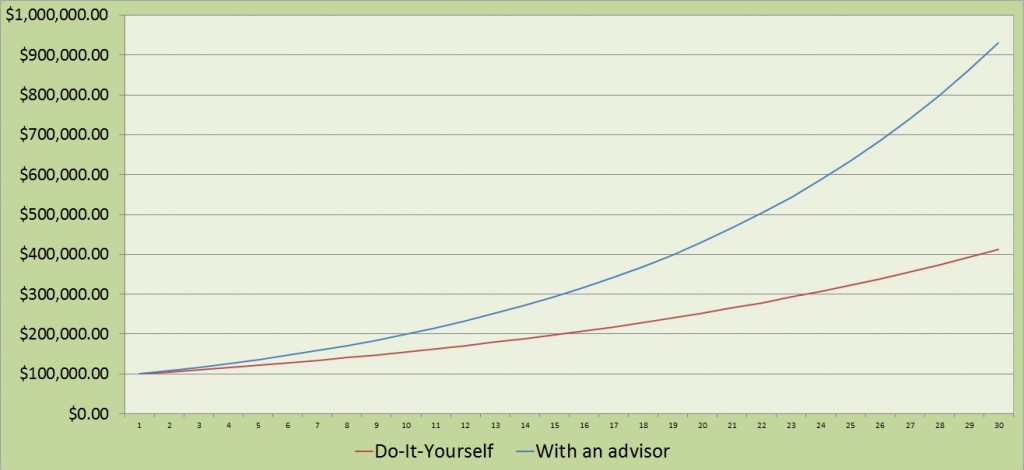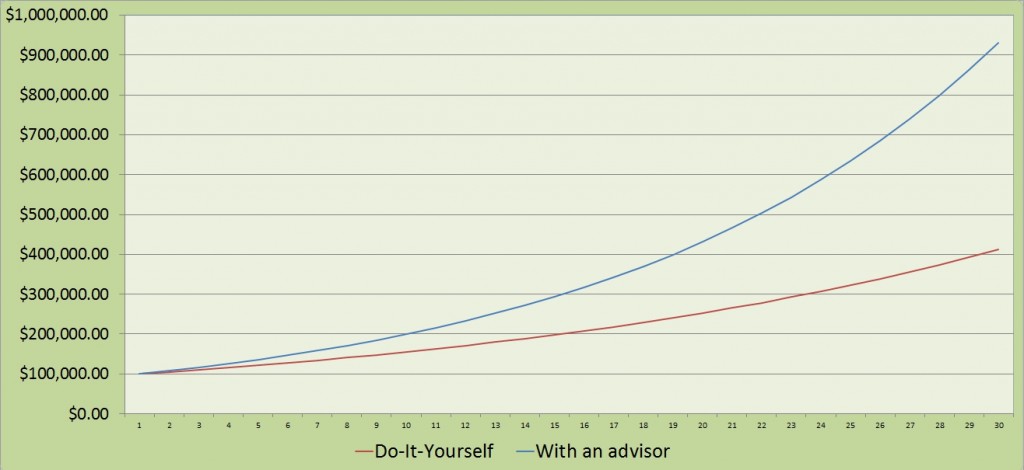Quantifying the value of any service can be difficult, and quantifying the value of the service provided by a financial advisor is no exception. Vanguard is known in the financial industry for its low-cost funds, index investing, and has been spearheading the do-it-yourself movement. However, they recently released a report using their very own data that found that investors who used an advisor had an average return over a full market cycle that was 3%/year greater than investors who did it themselves.
The above graph shows hypothetically how an additional 3% a year in returns compounding for 30 years increases the investors portfolio of $100,000. The investor’s account value is nearly double if they use an advisor vs. do-it-themselves.
This is not from beating the market every single year, but rather from the guidance and advice that advisors offer during critical points in the market cycle.
Their data showed that advisors add value in 7 specific ways that contributed to the increased returns.
The 7 Advisor Advantages:
1) Behavioral coaching: This is where advisors added the most value to client returns. Investors who stayed disciplined through the most crucial times (market peaks and market valleys) values will add large returns. We talk about this often as being the single largest contributor to generating long term returns, making good decisions and staying the course at market extremes. The natural human tendency that many investors have is to take on more risk when the market is doing well because it seems safe to do so (since the market is doing well, it will surely continue to do well, right?). And when the market breaks down and declines, the natural reaction is to sell and get out. We speak about this often with our clients, that this is the exact opposite behavior that leads to real returns in the long run.
Dalbar produces an annual report called the Quantitative Analysis of Investor Behavior that we often cite, and the most recent edition shows the 20-year return of the market to be 7.81%/year, while the average investor returns from equity mutual funds is 3.49%/year. This gap is entirely attributed to making the wrong behavioral decision at the wrong time.
2) Asset Allocation: Investors who do it themselves often end up in an asset allocation that is driven by headlines and gut reactions. This is important because it drives the return volatility and performance, which often leads one back to the behavioral decisions noted above (taking on too much risk at the wrong time, and taking on too little risk at the wrong time).
Investing in a diversified portfolio of securities that will deliver the right risk/return characteristics is a significant contributor to generating better returns over time.
3) Cost Effectiveness: On average, investors using an Advisor saw an increase in return of about .45% related to fund fees. This was primarily the result of being placed in lower-cost funds by the Advisor.
These savings can also come from the efficiencies of having all accounts in the portfolio managed together, thus avoiding redundancy and/or holding all the same positions in each account.
4) Rebalancing: In order to reduce risk and volatility, investors must rebalance. Rebalancing can take advantage of short term corrections of certain assets while reducing risk in short term highs of other assets.
Although rebalancing’s primary function is to reduce risk, it is also a disciplined and systematic way to buy low and sell high little by little over time.
5) Asset Location: The knowledge of what types of accounts to have and how much to have in each account is imperative to building wealth. Putting too much money into the wrong account can have tax implications which in turn hurt the returns of that account. Choosing the correct types of accounts to invest in depending on their independent purpose can give you tax deductions, tax free growth, or tax free withdrawals. Investors who do not take advantage of these properly leave significant money on the table by paying too much in taxes.
6) Withdrawal order from assets: When the time comes of retiring, knowing which accounts to take from first and which ones to leave alone can leave investors with more money to use. In general the correct formula depends on the investor’s situation, but it is usually best to use the tax free money last and use investment gains first. Having the correct order of account withdrawals adds returns in the form of saved taxes and extending tax free money.
7) Total return vs income investing: Instead of relying on the old rules of retiring, a savvy advisor can add longevity and stableness to investors’ money. Decades ago investors could depend on bonds to provide the income necessary for retirement through their dividends and interest.
Now interest rates are hovering around all-time lows bonds do not have the interest needed to support retirement. An advisor can help by using creative investments that have higher interest rates and growth than bonds. Also, deciding what assets to take money from and which to let grow further can have significant implications on an investors retirement and having a knowledgeable advisor’s expertise helps immensely.
How To Capture the added 3%/Year
All together these portfolio improvements along with behavioral guidance and advice add 3% annualized a year to investor’s returns. The majority of the added returns occur during market peaks and valleys which tend to be when advisors talk clients into staying the course and not getting greedy or fearful.
When investor’s returns deviate from what their friends and the markets are returning, people can have a hard time staying the course even though these strategies can potentially have much greater returns in the long run. This can have added benefit of potentially greater returns over time, but are also more challenging in the short term market peaks when the US market is the best performing asset class.
Successful investors find an advisor that they trust and will take advice from and simply follow their guidance. This adds more in returns than any sort of fancy investment strategy can possibly add. Find yours and your added 3% a year in returns will compound to a fortune through your lifetime.


